A Study on Employment Opportunities for Disabled Individuals in UK
VerifiedAdded on 2020/11/12
|44
|12844
|441
Report
AI Summary
This report investigates the employment landscape for disabled individuals, focusing on the challenges and opportunities they face in the workplace. It begins by defining disability and highlighting the misconceptions and discrimination disabled people encounter, which often limit their employment prospects. The research explores the causes of discrimination, examining employer attitudes, organizational practices, and the impact of societal biases. It delves into the role of training and education in equipping disabled individuals with necessary skills, and assesses the impact of technological advancements in enabling remote work and enhancing workplace accessibility. The report also analyzes the social and economic implications of disabled people's employment, including the benefits of inclusion and the consequences of exclusion. Through a mixed-method approach, the study identifies interventions to promote employment, eliminate discrimination, and improve the overall integration of disabled people into the workforce, offering recommendations for policy and practice.
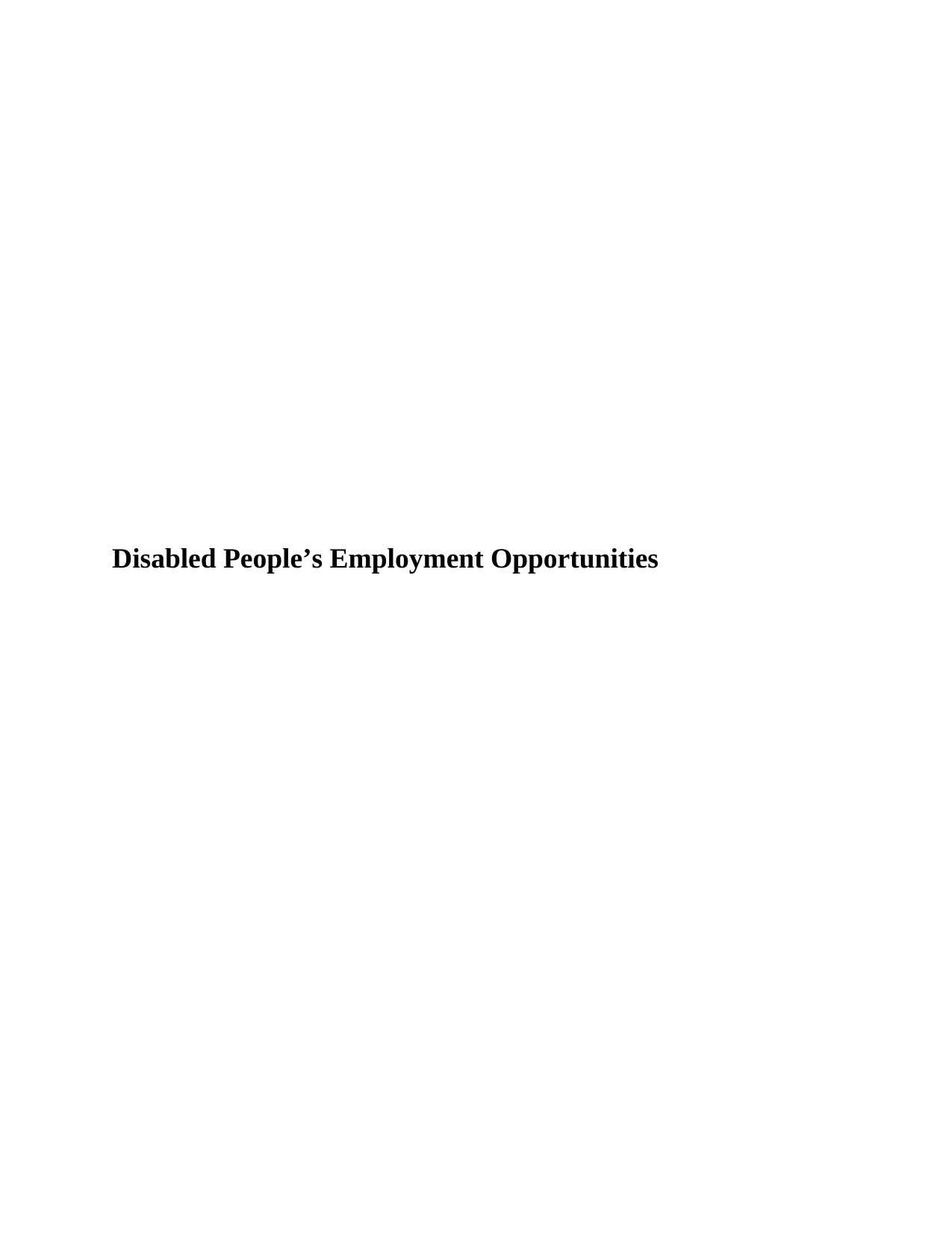
Disabled People’s Employment Opportunities
Paraphrase This Document
Need a fresh take? Get an instant paraphrase of this document with our AI Paraphraser

Employment Opportunities 2
Abstract
This study has been conducted in order to find out the causes and factors which have been
followed in multinational, international and small and medium organisations against disabled
people. There is a wrongly perceived image of people with disabilities. Disabled people are
considered as violent, aggressive and impulsive in different matters and it has been perceived
that they are lacking in regards of problem solving skills and decision making skills. There are
multiple types of disabilities and the rate of such factors is also dependent on the type of
disability. Physical, sensory, psychological and mental disabilities are some of the types which
affects the productivity and performance of a person.
This research evaluates the causes of such discrimination in the organisations. This has been
done through secondary research methods. There are several other ways through which the
disabled people can get employed to organisations. This can be done through technological
advancements and new developments in technologies. This allows disabled people to work
effectively from home so that they could feel discriminated at their workplace.
Key words – disability, employment, organisations, rehabilitation, trainings, education,
impairment, technological advancements, discrimination.
Abstract
This study has been conducted in order to find out the causes and factors which have been
followed in multinational, international and small and medium organisations against disabled
people. There is a wrongly perceived image of people with disabilities. Disabled people are
considered as violent, aggressive and impulsive in different matters and it has been perceived
that they are lacking in regards of problem solving skills and decision making skills. There are
multiple types of disabilities and the rate of such factors is also dependent on the type of
disability. Physical, sensory, psychological and mental disabilities are some of the types which
affects the productivity and performance of a person.
This research evaluates the causes of such discrimination in the organisations. This has been
done through secondary research methods. There are several other ways through which the
disabled people can get employed to organisations. This can be done through technological
advancements and new developments in technologies. This allows disabled people to work
effectively from home so that they could feel discriminated at their workplace.
Key words – disability, employment, organisations, rehabilitation, trainings, education,
impairment, technological advancements, discrimination.
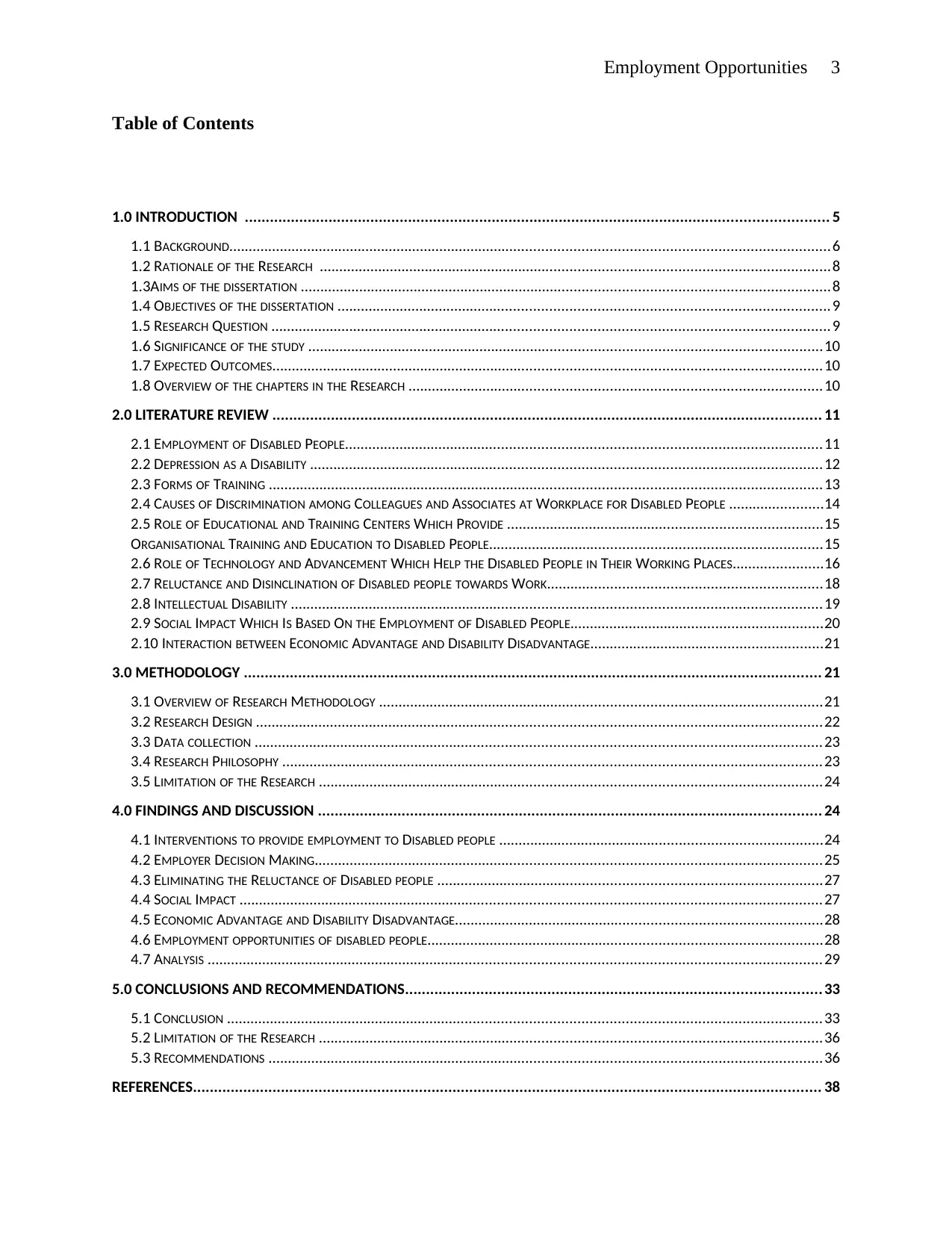
Employment Opportunities 3
Table of Contents
1.0 INTRODUCTION ........................................................................................................................................... 5
1.1 BACKGROUND........................................................................................................................................................6
1.2 RATIONALE OF THE RESEARCH .................................................................................................................................8
1.3AIMS OF THE DISSERTATION ......................................................................................................................................8
1.4 OBJECTIVES OF THE DISSERTATION ............................................................................................................................9
1.5 RESEARCH QUESTION .............................................................................................................................................9
1.6 SIGNIFICANCE OF THE STUDY ..................................................................................................................................10
1.7 EXPECTED OUTCOMES...........................................................................................................................................10
1.8 OVERVIEW OF THE CHAPTERS IN THE RESEARCH ........................................................................................................10
2.0 LITERATURE REVIEW ................................................................................................................................... 11
2.1 EMPLOYMENT OF DISABLED PEOPLE........................................................................................................................11
2.2 DEPRESSION AS A DISABILITY .................................................................................................................................12
2.3 FORMS OF TRAINING ............................................................................................................................................13
2.4 CAUSES OF DISCRIMINATION AMONG COLLEAGUES AND ASSOCIATES AT WORKPLACE FOR DISABLED PEOPLE ........................14
2.5 ROLE OF EDUCATIONAL AND TRAINING CENTERS WHICH PROVIDE ................................................................................15
ORGANISATIONAL TRAINING AND EDUCATION TO DISABLED PEOPLE....................................................................................15
2.6 ROLE OF TECHNOLOGY AND ADVANCEMENT WHICH HELP THE DISABLED PEOPLE IN THEIR WORKING PLACES.......................16
2.7 RELUCTANCE AND DISINCLINATION OF DISABLED PEOPLE TOWARDS WORK.....................................................................18
2.8 INTELLECTUAL DISABILITY ......................................................................................................................................19
2.9 SOCIAL IMPACT WHICH IS BASED ON THE EMPLOYMENT OF DISABLED PEOPLE................................................................20
2.10 INTERACTION BETWEEN ECONOMIC ADVANTAGE AND DISABILITY DISADVANTAGE...........................................................21
3.0 METHODOLOGY .......................................................................................................................................... 21
3.1 OVERVIEW OF RESEARCH METHODOLOGY ................................................................................................................21
3.2 RESEARCH DESIGN ...............................................................................................................................................22
3.3 DATA COLLECTION ...............................................................................................................................................23
3.4 RESEARCH PHILOSOPHY ........................................................................................................................................23
3.5 LIMITATION OF THE RESEARCH ...............................................................................................................................24
4.0 FINDINGS AND DISCUSSION ........................................................................................................................ 24
4.1 INTERVENTIONS TO PROVIDE EMPLOYMENT TO DISABLED PEOPLE ..................................................................................24
4.2 EMPLOYER DECISION MAKING................................................................................................................................25
4.3 ELIMINATING THE RELUCTANCE OF DISABLED PEOPLE .................................................................................................27
4.4 SOCIAL IMPACT ...................................................................................................................................................27
4.5 ECONOMIC ADVANTAGE AND DISABILITY DISADVANTAGE.............................................................................................28
4.6 EMPLOYMENT OPPORTUNITIES OF DISABLED PEOPLE....................................................................................................28
4.7 ANALYSIS ...........................................................................................................................................................29
5.0 CONCLUSIONS AND RECOMMENDATIONS................................................................................................... 33
5.1 CONCLUSION ......................................................................................................................................................33
5.2 LIMITATION OF THE RESEARCH ...............................................................................................................................36
5.3 RECOMMENDATIONS ............................................................................................................................................36
REFERENCES...................................................................................................................................................... 38
Table of Contents
1.0 INTRODUCTION ........................................................................................................................................... 5
1.1 BACKGROUND........................................................................................................................................................6
1.2 RATIONALE OF THE RESEARCH .................................................................................................................................8
1.3AIMS OF THE DISSERTATION ......................................................................................................................................8
1.4 OBJECTIVES OF THE DISSERTATION ............................................................................................................................9
1.5 RESEARCH QUESTION .............................................................................................................................................9
1.6 SIGNIFICANCE OF THE STUDY ..................................................................................................................................10
1.7 EXPECTED OUTCOMES...........................................................................................................................................10
1.8 OVERVIEW OF THE CHAPTERS IN THE RESEARCH ........................................................................................................10
2.0 LITERATURE REVIEW ................................................................................................................................... 11
2.1 EMPLOYMENT OF DISABLED PEOPLE........................................................................................................................11
2.2 DEPRESSION AS A DISABILITY .................................................................................................................................12
2.3 FORMS OF TRAINING ............................................................................................................................................13
2.4 CAUSES OF DISCRIMINATION AMONG COLLEAGUES AND ASSOCIATES AT WORKPLACE FOR DISABLED PEOPLE ........................14
2.5 ROLE OF EDUCATIONAL AND TRAINING CENTERS WHICH PROVIDE ................................................................................15
ORGANISATIONAL TRAINING AND EDUCATION TO DISABLED PEOPLE....................................................................................15
2.6 ROLE OF TECHNOLOGY AND ADVANCEMENT WHICH HELP THE DISABLED PEOPLE IN THEIR WORKING PLACES.......................16
2.7 RELUCTANCE AND DISINCLINATION OF DISABLED PEOPLE TOWARDS WORK.....................................................................18
2.8 INTELLECTUAL DISABILITY ......................................................................................................................................19
2.9 SOCIAL IMPACT WHICH IS BASED ON THE EMPLOYMENT OF DISABLED PEOPLE................................................................20
2.10 INTERACTION BETWEEN ECONOMIC ADVANTAGE AND DISABILITY DISADVANTAGE...........................................................21
3.0 METHODOLOGY .......................................................................................................................................... 21
3.1 OVERVIEW OF RESEARCH METHODOLOGY ................................................................................................................21
3.2 RESEARCH DESIGN ...............................................................................................................................................22
3.3 DATA COLLECTION ...............................................................................................................................................23
3.4 RESEARCH PHILOSOPHY ........................................................................................................................................23
3.5 LIMITATION OF THE RESEARCH ...............................................................................................................................24
4.0 FINDINGS AND DISCUSSION ........................................................................................................................ 24
4.1 INTERVENTIONS TO PROVIDE EMPLOYMENT TO DISABLED PEOPLE ..................................................................................24
4.2 EMPLOYER DECISION MAKING................................................................................................................................25
4.3 ELIMINATING THE RELUCTANCE OF DISABLED PEOPLE .................................................................................................27
4.4 SOCIAL IMPACT ...................................................................................................................................................27
4.5 ECONOMIC ADVANTAGE AND DISABILITY DISADVANTAGE.............................................................................................28
4.6 EMPLOYMENT OPPORTUNITIES OF DISABLED PEOPLE....................................................................................................28
4.7 ANALYSIS ...........................................................................................................................................................29
5.0 CONCLUSIONS AND RECOMMENDATIONS................................................................................................... 33
5.1 CONCLUSION ......................................................................................................................................................33
5.2 LIMITATION OF THE RESEARCH ...............................................................................................................................36
5.3 RECOMMENDATIONS ............................................................................................................................................36
REFERENCES...................................................................................................................................................... 38
⊘ This is a preview!⊘
Do you want full access?
Subscribe today to unlock all pages.

Trusted by 1+ million students worldwide

Employment Opportunities 4
Paraphrase This Document
Need a fresh take? Get an instant paraphrase of this document with our AI Paraphraser
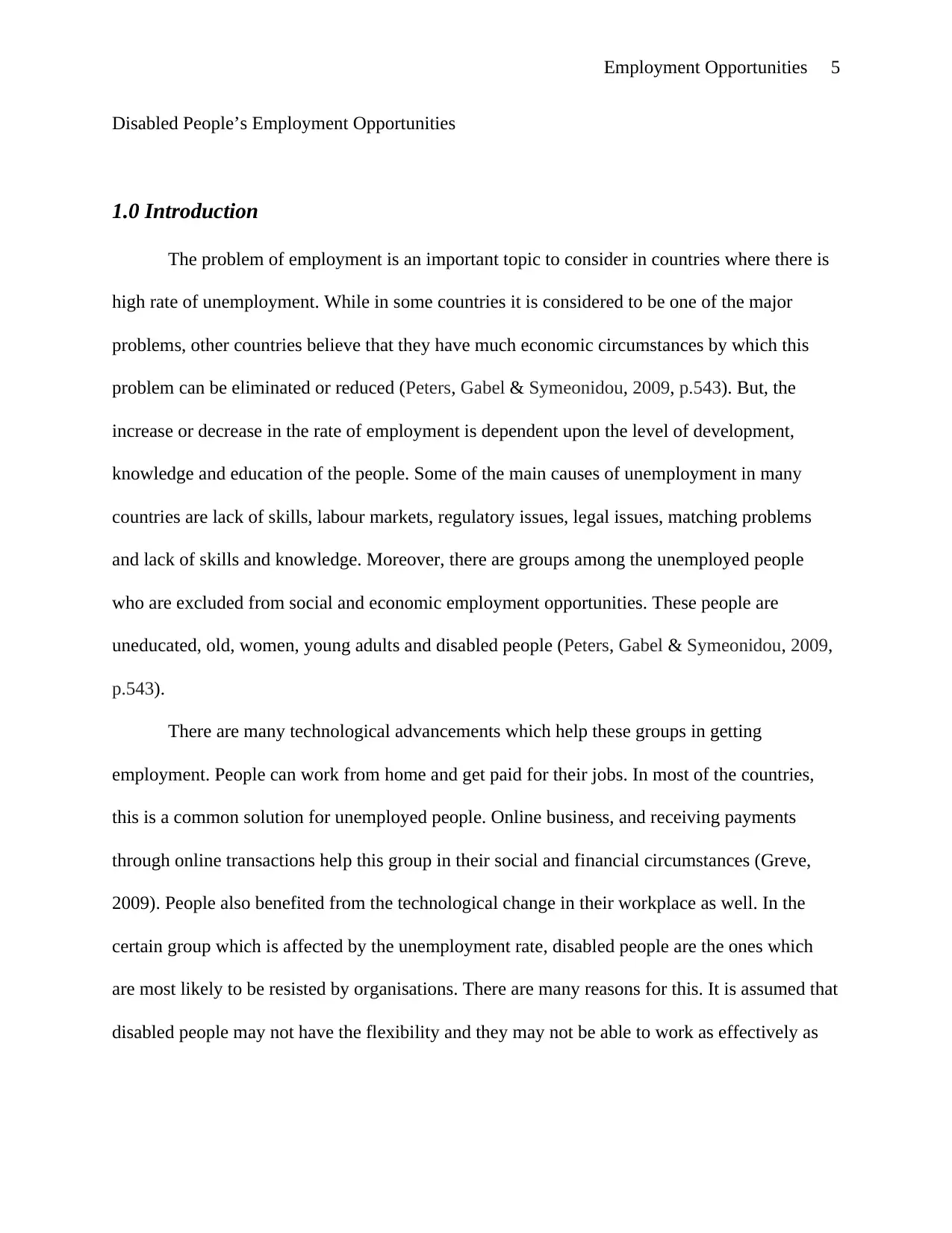
Employment Opportunities 5
Disabled People’s Employment Opportunities
1.0 Introduction
The problem of employment is an important topic to consider in countries where there is
high rate of unemployment. While in some countries it is considered to be one of the major
problems, other countries believe that they have much economic circumstances by which this
problem can be eliminated or reduced (Peters, Gabel & Symeonidou, 2009, p.543). But, the
increase or decrease in the rate of employment is dependent upon the level of development,
knowledge and education of the people. Some of the main causes of unemployment in many
countries are lack of skills, labour markets, regulatory issues, legal issues, matching problems
and lack of skills and knowledge. Moreover, there are groups among the unemployed people
who are excluded from social and economic employment opportunities. These people are
uneducated, old, women, young adults and disabled people (Peters, Gabel & Symeonidou, 2009,
p.543).
There are many technological advancements which help these groups in getting
employment. People can work from home and get paid for their jobs. In most of the countries,
this is a common solution for unemployed people. Online business, and receiving payments
through online transactions help this group in their social and financial circumstances (Greve,
2009). People also benefited from the technological change in their workplace as well. In the
certain group which is affected by the unemployment rate, disabled people are the ones which
are most likely to be resisted by organisations. There are many reasons for this. It is assumed that
disabled people may not have the flexibility and they may not be able to work as effectively as
Disabled People’s Employment Opportunities
1.0 Introduction
The problem of employment is an important topic to consider in countries where there is
high rate of unemployment. While in some countries it is considered to be one of the major
problems, other countries believe that they have much economic circumstances by which this
problem can be eliminated or reduced (Peters, Gabel & Symeonidou, 2009, p.543). But, the
increase or decrease in the rate of employment is dependent upon the level of development,
knowledge and education of the people. Some of the main causes of unemployment in many
countries are lack of skills, labour markets, regulatory issues, legal issues, matching problems
and lack of skills and knowledge. Moreover, there are groups among the unemployed people
who are excluded from social and economic employment opportunities. These people are
uneducated, old, women, young adults and disabled people (Peters, Gabel & Symeonidou, 2009,
p.543).
There are many technological advancements which help these groups in getting
employment. People can work from home and get paid for their jobs. In most of the countries,
this is a common solution for unemployed people. Online business, and receiving payments
through online transactions help this group in their social and financial circumstances (Greve,
2009). People also benefited from the technological change in their workplace as well. In the
certain group which is affected by the unemployment rate, disabled people are the ones which
are most likely to be resisted by organisations. There are many reasons for this. It is assumed that
disabled people may not have the flexibility and they may not be able to work as effectively as
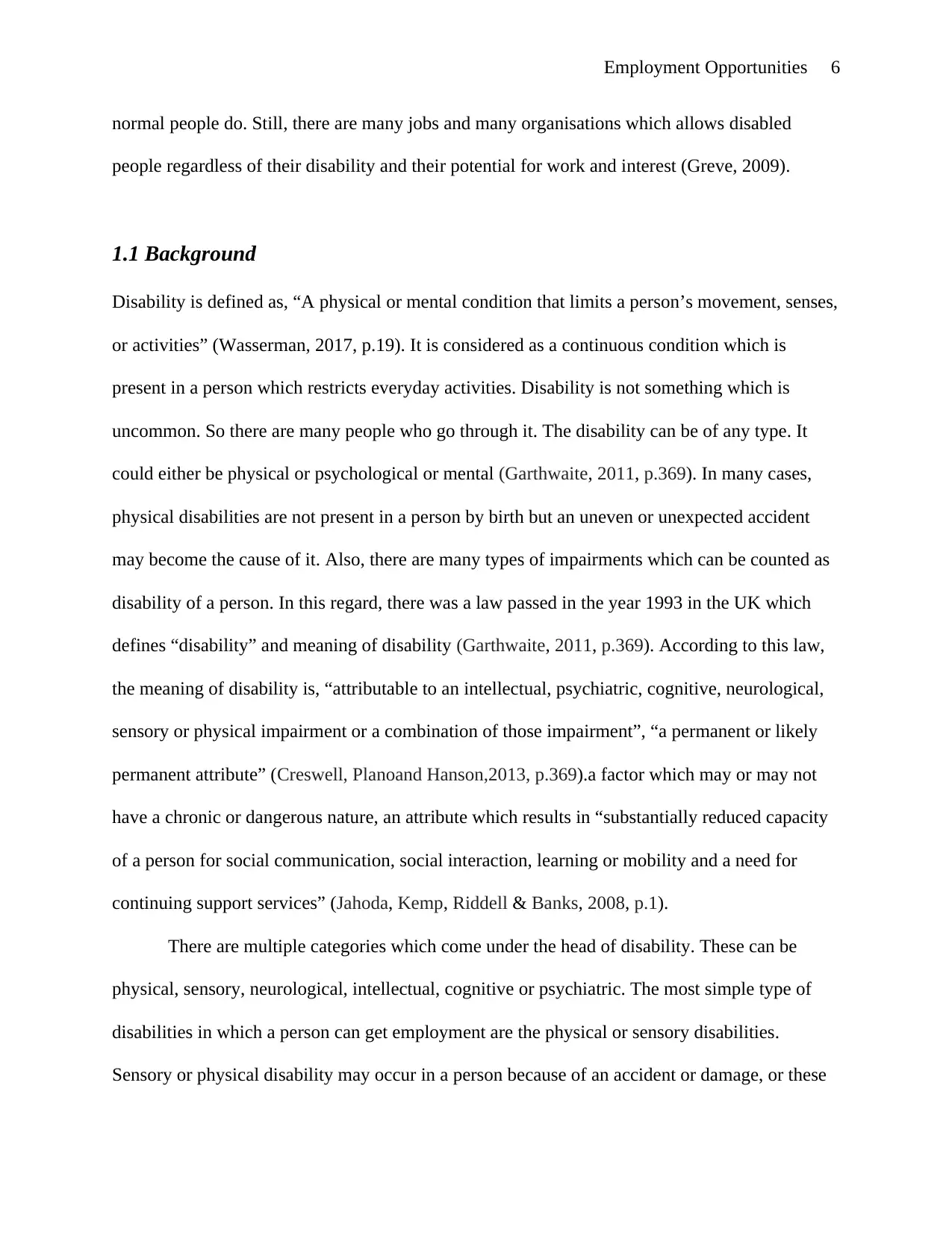
Employment Opportunities 6
normal people do. Still, there are many jobs and many organisations which allows disabled
people regardless of their disability and their potential for work and interest (Greve, 2009).
1.1 Background
Disability is defined as, “A physical or mental condition that limits a person’s movement, senses,
or activities” (Wasserman, 2017, p.19). It is considered as a continuous condition which is
present in a person which restricts everyday activities. Disability is not something which is
uncommon. So there are many people who go through it. The disability can be of any type. It
could either be physical or psychological or mental (Garthwaite, 2011, p.369). In many cases,
physical disabilities are not present in a person by birth but an uneven or unexpected accident
may become the cause of it. Also, there are many types of impairments which can be counted as
disability of a person. In this regard, there was a law passed in the year 1993 in the UK which
defines “disability” and meaning of disability (Garthwaite, 2011, p.369). According to this law,
the meaning of disability is, “attributable to an intellectual, psychiatric, cognitive, neurological,
sensory or physical impairment or a combination of those impairment”, “a permanent or likely
permanent attribute” (Creswell, Planoand Hanson,2013, p.369).a factor which may or may not
have a chronic or dangerous nature, an attribute which results in “substantially reduced capacity
of a person for social communication, social interaction, learning or mobility and a need for
continuing support services” (Jahoda, Kemp, Riddell & Banks, 2008, p.1).
There are multiple categories which come under the head of disability. These can be
physical, sensory, neurological, intellectual, cognitive or psychiatric. The most simple type of
disabilities in which a person can get employment are the physical or sensory disabilities.
Sensory or physical disability may occur in a person because of an accident or damage, or these
normal people do. Still, there are many jobs and many organisations which allows disabled
people regardless of their disability and their potential for work and interest (Greve, 2009).
1.1 Background
Disability is defined as, “A physical or mental condition that limits a person’s movement, senses,
or activities” (Wasserman, 2017, p.19). It is considered as a continuous condition which is
present in a person which restricts everyday activities. Disability is not something which is
uncommon. So there are many people who go through it. The disability can be of any type. It
could either be physical or psychological or mental (Garthwaite, 2011, p.369). In many cases,
physical disabilities are not present in a person by birth but an uneven or unexpected accident
may become the cause of it. Also, there are many types of impairments which can be counted as
disability of a person. In this regard, there was a law passed in the year 1993 in the UK which
defines “disability” and meaning of disability (Garthwaite, 2011, p.369). According to this law,
the meaning of disability is, “attributable to an intellectual, psychiatric, cognitive, neurological,
sensory or physical impairment or a combination of those impairment”, “a permanent or likely
permanent attribute” (Creswell, Planoand Hanson,2013, p.369).a factor which may or may not
have a chronic or dangerous nature, an attribute which results in “substantially reduced capacity
of a person for social communication, social interaction, learning or mobility and a need for
continuing support services” (Jahoda, Kemp, Riddell & Banks, 2008, p.1).
There are multiple categories which come under the head of disability. These can be
physical, sensory, neurological, intellectual, cognitive or psychiatric. The most simple type of
disabilities in which a person can get employment are the physical or sensory disabilities.
Sensory or physical disability may occur in a person because of an accident or damage, or these
⊘ This is a preview!⊘
Do you want full access?
Subscribe today to unlock all pages.

Trusted by 1+ million students worldwide

Employment Opportunities 7
could be a part of a person’s appearance by birth (Jahoda et al., 2008, p.1). People who are not
considered as disable and who are working as employees or looking for a job. They may have
some kind of disability as well. Minor disorders, anxiety, depression, stress or phobias are also a
kind of disability which affect the productivity of a person. Disability of a person may also have
short term or long term effects. These effects should not be considered in a long term to hire a
person for a job (Jahoda et al., 2008, p.1).
It has been observed that people who go through any major or minor kind of disability
also have to face problems in terms of their social life, education, training and employment
opportunities. Disabled people are considered to be the most discriminated group in terms of
their inclusion in society and communities (Henderson, 2011, p.198). There is a strong need to
change the perception of the people related to disability discrimination in their employment and
acceptance in society. There are many studies and researches which have been done in the regard
of acceptance of disabled people and marking them equal to being marginal and dependant
because of individual inadequacy (Henderson, 2011, p.198).
The employment rate of normal people and people with disabilities has a very wide gap. The
target market which is supposed to bring down the rate of unemployment cannot be achieved if
the issue of disabled people’s unemployment is not addressed and taken care of properly
(Henderson, 2011, p.198). Disabled unemployed people are approximately 5 to 6 percent of the
total population in UK (Barton, 2017, p. 43). Different programs were initiated and different
methods were used to employ disabled people by private local and international companies and
government organisations to hire people in the fields which does not require much efforts and
efficiency (Henderson, 2011, p.198).
could be a part of a person’s appearance by birth (Jahoda et al., 2008, p.1). People who are not
considered as disable and who are working as employees or looking for a job. They may have
some kind of disability as well. Minor disorders, anxiety, depression, stress or phobias are also a
kind of disability which affect the productivity of a person. Disability of a person may also have
short term or long term effects. These effects should not be considered in a long term to hire a
person for a job (Jahoda et al., 2008, p.1).
It has been observed that people who go through any major or minor kind of disability
also have to face problems in terms of their social life, education, training and employment
opportunities. Disabled people are considered to be the most discriminated group in terms of
their inclusion in society and communities (Henderson, 2011, p.198). There is a strong need to
change the perception of the people related to disability discrimination in their employment and
acceptance in society. There are many studies and researches which have been done in the regard
of acceptance of disabled people and marking them equal to being marginal and dependant
because of individual inadequacy (Henderson, 2011, p.198).
The employment rate of normal people and people with disabilities has a very wide gap. The
target market which is supposed to bring down the rate of unemployment cannot be achieved if
the issue of disabled people’s unemployment is not addressed and taken care of properly
(Henderson, 2011, p.198). Disabled unemployed people are approximately 5 to 6 percent of the
total population in UK (Barton, 2017, p. 43). Different programs were initiated and different
methods were used to employ disabled people by private local and international companies and
government organisations to hire people in the fields which does not require much efforts and
efficiency (Henderson, 2011, p.198).
Paraphrase This Document
Need a fresh take? Get an instant paraphrase of this document with our AI Paraphraser
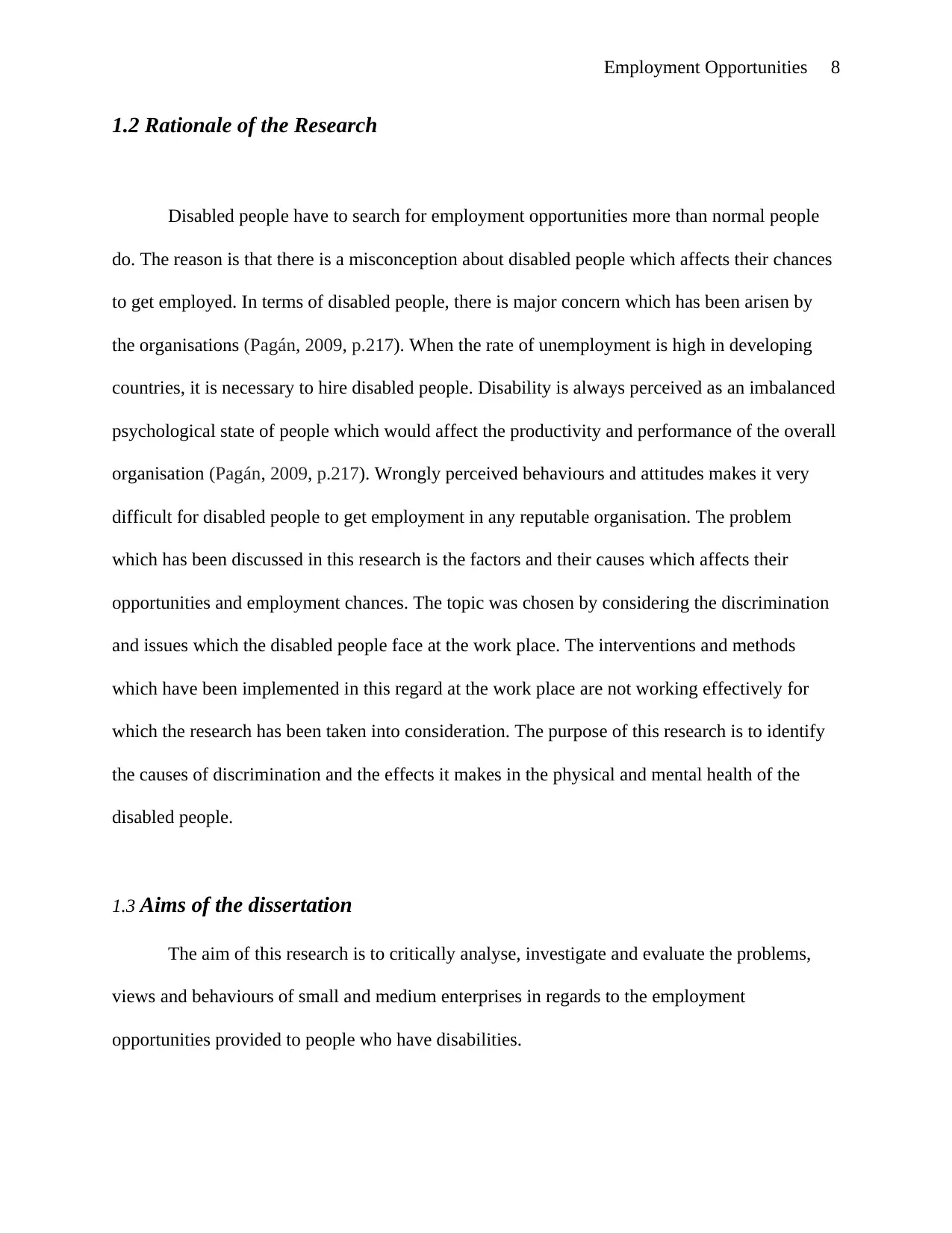
Employment Opportunities 8
1.2 Rationale of the Research
Disabled people have to search for employment opportunities more than normal people
do. The reason is that there is a misconception about disabled people which affects their chances
to get employed. In terms of disabled people, there is major concern which has been arisen by
the organisations (Pagán, 2009, p.217). When the rate of unemployment is high in developing
countries, it is necessary to hire disabled people. Disability is always perceived as an imbalanced
psychological state of people which would affect the productivity and performance of the overall
organisation (Pagán, 2009, p.217). Wrongly perceived behaviours and attitudes makes it very
difficult for disabled people to get employment in any reputable organisation. The problem
which has been discussed in this research is the factors and their causes which affects their
opportunities and employment chances. The topic was chosen by considering the discrimination
and issues which the disabled people face at the work place. The interventions and methods
which have been implemented in this regard at the work place are not working effectively for
which the research has been taken into consideration. The purpose of this research is to identify
the causes of discrimination and the effects it makes in the physical and mental health of the
disabled people.
1.3 Aims of the dissertation
The aim of this research is to critically analyse, investigate and evaluate the problems,
views and behaviours of small and medium enterprises in regards to the employment
opportunities provided to people who have disabilities.
1.2 Rationale of the Research
Disabled people have to search for employment opportunities more than normal people
do. The reason is that there is a misconception about disabled people which affects their chances
to get employed. In terms of disabled people, there is major concern which has been arisen by
the organisations (Pagán, 2009, p.217). When the rate of unemployment is high in developing
countries, it is necessary to hire disabled people. Disability is always perceived as an imbalanced
psychological state of people which would affect the productivity and performance of the overall
organisation (Pagán, 2009, p.217). Wrongly perceived behaviours and attitudes makes it very
difficult for disabled people to get employment in any reputable organisation. The problem
which has been discussed in this research is the factors and their causes which affects their
opportunities and employment chances. The topic was chosen by considering the discrimination
and issues which the disabled people face at the work place. The interventions and methods
which have been implemented in this regard at the work place are not working effectively for
which the research has been taken into consideration. The purpose of this research is to identify
the causes of discrimination and the effects it makes in the physical and mental health of the
disabled people.
1.3 Aims of the dissertation
The aim of this research is to critically analyse, investigate and evaluate the problems,
views and behaviours of small and medium enterprises in regards to the employment
opportunities provided to people who have disabilities.
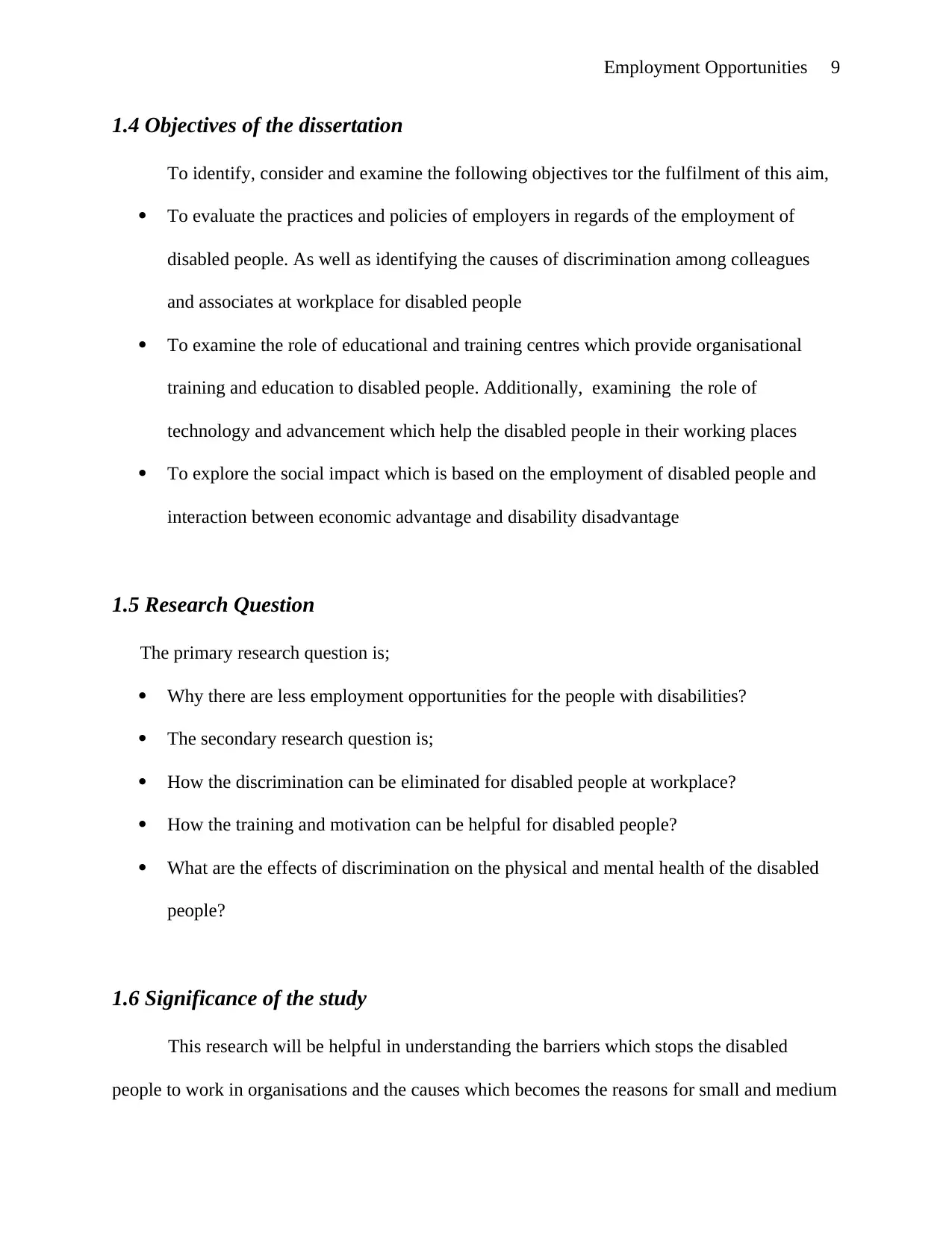
Employment Opportunities 9
1.4 Objectives of the dissertation
To identify, consider and examine the following objectives tor the fulfilment of this aim,
To evaluate the practices and policies of employers in regards of the employment of
disabled people. As well as identifying the causes of discrimination among colleagues
and associates at workplace for disabled people
To examine the role of educational and training centres which provide organisational
training and education to disabled people. Additionally, examining the role of
technology and advancement which help the disabled people in their working places
To explore the social impact which is based on the employment of disabled people and
interaction between economic advantage and disability disadvantage
1.5 Research Question
The primary research question is;
Why there are less employment opportunities for the people with disabilities?
The secondary research question is;
How the discrimination can be eliminated for disabled people at workplace?
How the training and motivation can be helpful for disabled people?
What are the effects of discrimination on the physical and mental health of the disabled
people?
1.6 Significance of the study
This research will be helpful in understanding the barriers which stops the disabled
people to work in organisations and the causes which becomes the reasons for small and medium
1.4 Objectives of the dissertation
To identify, consider and examine the following objectives tor the fulfilment of this aim,
To evaluate the practices and policies of employers in regards of the employment of
disabled people. As well as identifying the causes of discrimination among colleagues
and associates at workplace for disabled people
To examine the role of educational and training centres which provide organisational
training and education to disabled people. Additionally, examining the role of
technology and advancement which help the disabled people in their working places
To explore the social impact which is based on the employment of disabled people and
interaction between economic advantage and disability disadvantage
1.5 Research Question
The primary research question is;
Why there are less employment opportunities for the people with disabilities?
The secondary research question is;
How the discrimination can be eliminated for disabled people at workplace?
How the training and motivation can be helpful for disabled people?
What are the effects of discrimination on the physical and mental health of the disabled
people?
1.6 Significance of the study
This research will be helpful in understanding the barriers which stops the disabled
people to work in organisations and the causes which becomes the reasons for small and medium
⊘ This is a preview!⊘
Do you want full access?
Subscribe today to unlock all pages.

Trusted by 1+ million students worldwide
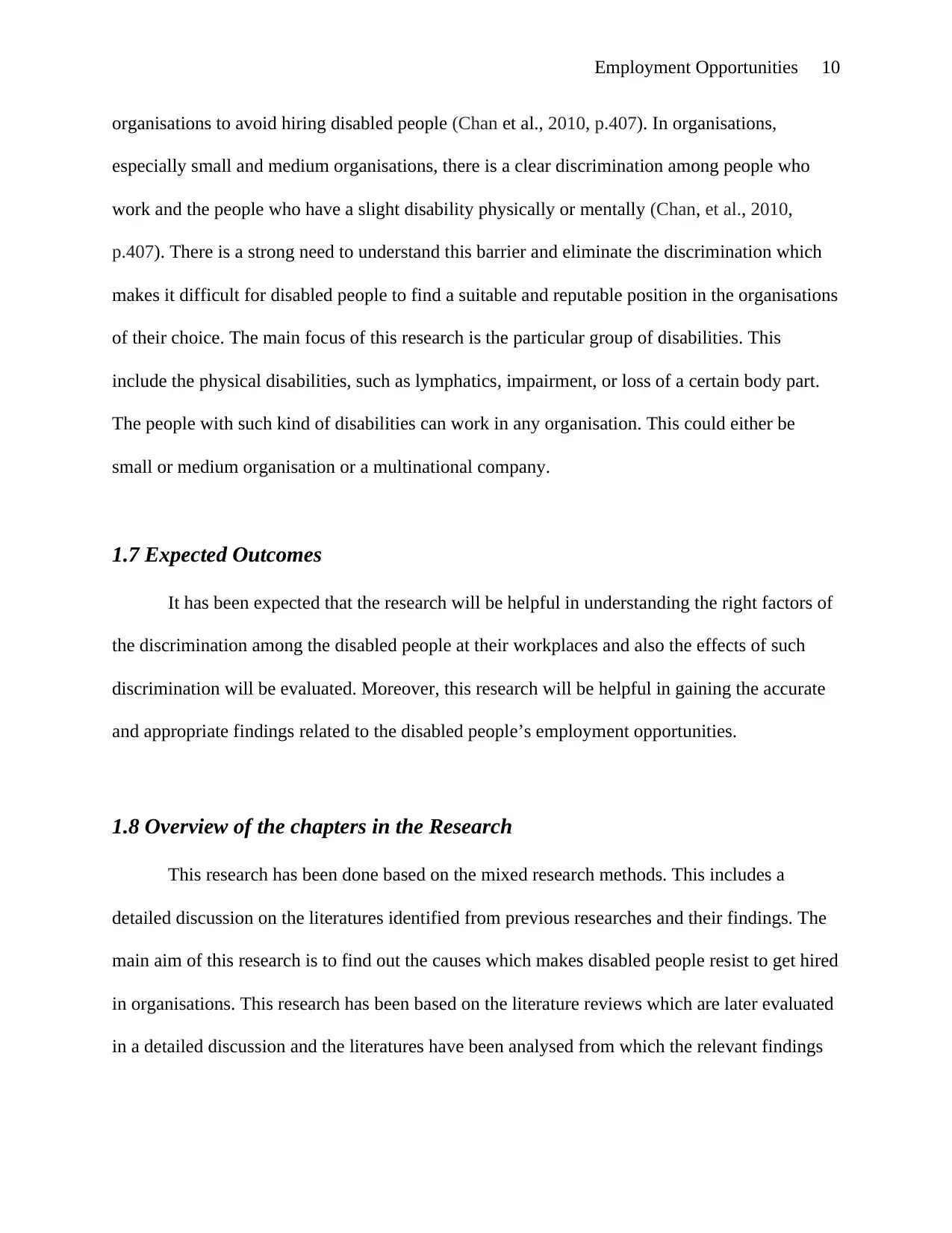
Employment Opportunities 10
organisations to avoid hiring disabled people (Chan et al., 2010, p.407). In organisations,
especially small and medium organisations, there is a clear discrimination among people who
work and the people who have a slight disability physically or mentally (Chan, et al., 2010,
p.407). There is a strong need to understand this barrier and eliminate the discrimination which
makes it difficult for disabled people to find a suitable and reputable position in the organisations
of their choice. The main focus of this research is the particular group of disabilities. This
include the physical disabilities, such as lymphatics, impairment, or loss of a certain body part.
The people with such kind of disabilities can work in any organisation. This could either be
small or medium organisation or a multinational company.
1.7 Expected Outcomes
It has been expected that the research will be helpful in understanding the right factors of
the discrimination among the disabled people at their workplaces and also the effects of such
discrimination will be evaluated. Moreover, this research will be helpful in gaining the accurate
and appropriate findings related to the disabled people’s employment opportunities.
1.8 Overview of the chapters in the Research
This research has been done based on the mixed research methods. This includes a
detailed discussion on the literatures identified from previous researches and their findings. The
main aim of this research is to find out the causes which makes disabled people resist to get hired
in organisations. This research has been based on the literature reviews which are later evaluated
in a detailed discussion and the literatures have been analysed from which the relevant findings
organisations to avoid hiring disabled people (Chan et al., 2010, p.407). In organisations,
especially small and medium organisations, there is a clear discrimination among people who
work and the people who have a slight disability physically or mentally (Chan, et al., 2010,
p.407). There is a strong need to understand this barrier and eliminate the discrimination which
makes it difficult for disabled people to find a suitable and reputable position in the organisations
of their choice. The main focus of this research is the particular group of disabilities. This
include the physical disabilities, such as lymphatics, impairment, or loss of a certain body part.
The people with such kind of disabilities can work in any organisation. This could either be
small or medium organisation or a multinational company.
1.7 Expected Outcomes
It has been expected that the research will be helpful in understanding the right factors of
the discrimination among the disabled people at their workplaces and also the effects of such
discrimination will be evaluated. Moreover, this research will be helpful in gaining the accurate
and appropriate findings related to the disabled people’s employment opportunities.
1.8 Overview of the chapters in the Research
This research has been done based on the mixed research methods. This includes a
detailed discussion on the literatures identified from previous researches and their findings. The
main aim of this research is to find out the causes which makes disabled people resist to get hired
in organisations. This research has been based on the literature reviews which are later evaluated
in a detailed discussion and the literatures have been analysed from which the relevant findings
Paraphrase This Document
Need a fresh take? Get an instant paraphrase of this document with our AI Paraphraser
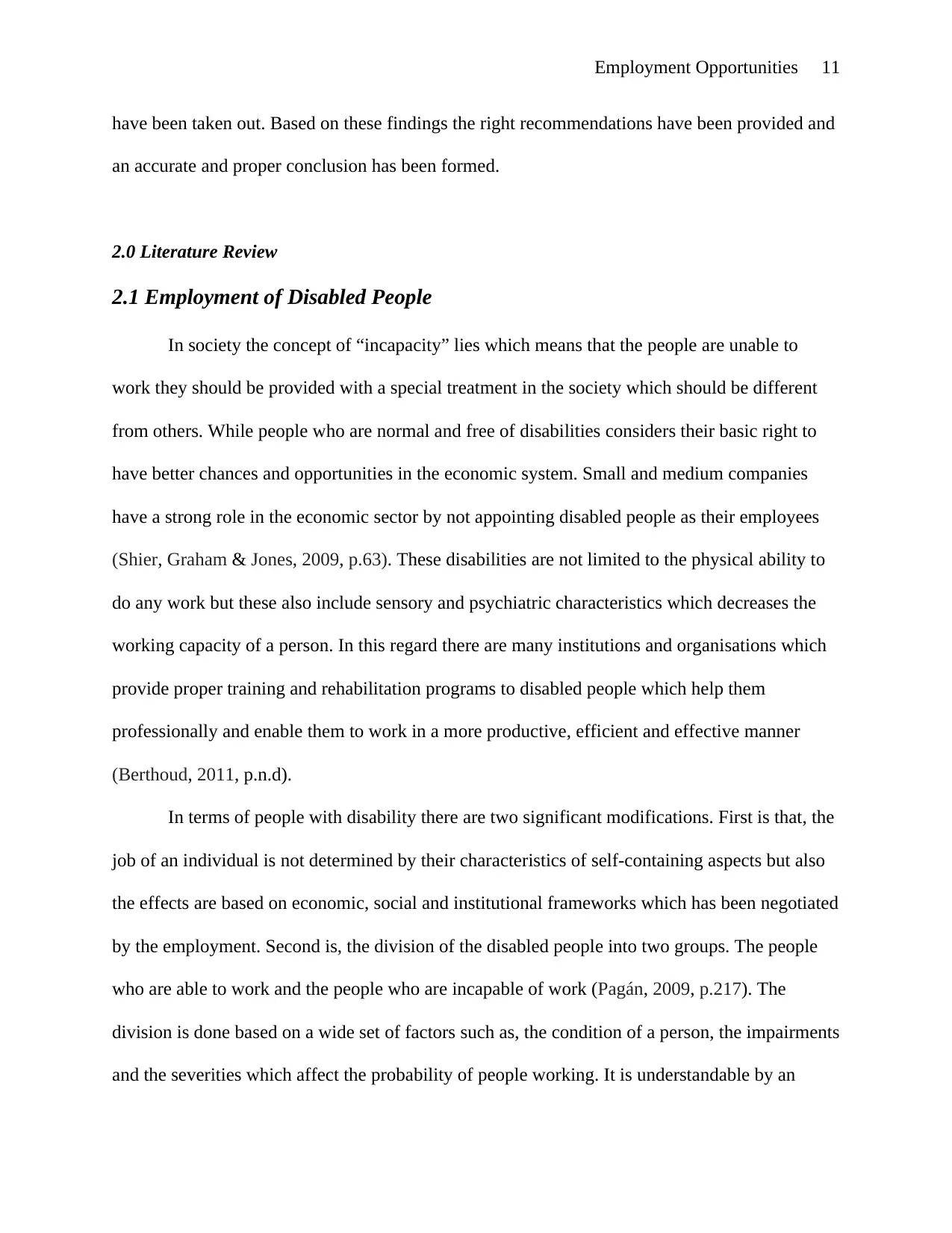
Employment Opportunities 11
have been taken out. Based on these findings the right recommendations have been provided and
an accurate and proper conclusion has been formed.
2.0 Literature Review
2.1 Employment of Disabled People
In society the concept of “incapacity” lies which means that the people are unable to
work they should be provided with a special treatment in the society which should be different
from others. While people who are normal and free of disabilities considers their basic right to
have better chances and opportunities in the economic system. Small and medium companies
have a strong role in the economic sector by not appointing disabled people as their employees
(Shier, Graham & Jones, 2009, p.63). These disabilities are not limited to the physical ability to
do any work but these also include sensory and psychiatric characteristics which decreases the
working capacity of a person. In this regard there are many institutions and organisations which
provide proper training and rehabilitation programs to disabled people which help them
professionally and enable them to work in a more productive, efficient and effective manner
(Berthoud, 2011, p.n.d).
In terms of people with disability there are two significant modifications. First is that, the
job of an individual is not determined by their characteristics of self-containing aspects but also
the effects are based on economic, social and institutional frameworks which has been negotiated
by the employment. Second is, the division of the disabled people into two groups. The people
who are able to work and the people who are incapable of work (Pagán, 2009, p.217). The
division is done based on a wide set of factors such as, the condition of a person, the impairments
and the severities which affect the probability of people working. It is understandable by an
have been taken out. Based on these findings the right recommendations have been provided and
an accurate and proper conclusion has been formed.
2.0 Literature Review
2.1 Employment of Disabled People
In society the concept of “incapacity” lies which means that the people are unable to
work they should be provided with a special treatment in the society which should be different
from others. While people who are normal and free of disabilities considers their basic right to
have better chances and opportunities in the economic system. Small and medium companies
have a strong role in the economic sector by not appointing disabled people as their employees
(Shier, Graham & Jones, 2009, p.63). These disabilities are not limited to the physical ability to
do any work but these also include sensory and psychiatric characteristics which decreases the
working capacity of a person. In this regard there are many institutions and organisations which
provide proper training and rehabilitation programs to disabled people which help them
professionally and enable them to work in a more productive, efficient and effective manner
(Berthoud, 2011, p.n.d).
In terms of people with disability there are two significant modifications. First is that, the
job of an individual is not determined by their characteristics of self-containing aspects but also
the effects are based on economic, social and institutional frameworks which has been negotiated
by the employment. Second is, the division of the disabled people into two groups. The people
who are able to work and the people who are incapable of work (Pagán, 2009, p.217). The
division is done based on a wide set of factors such as, the condition of a person, the impairments
and the severities which affect the probability of people working. It is understandable by an
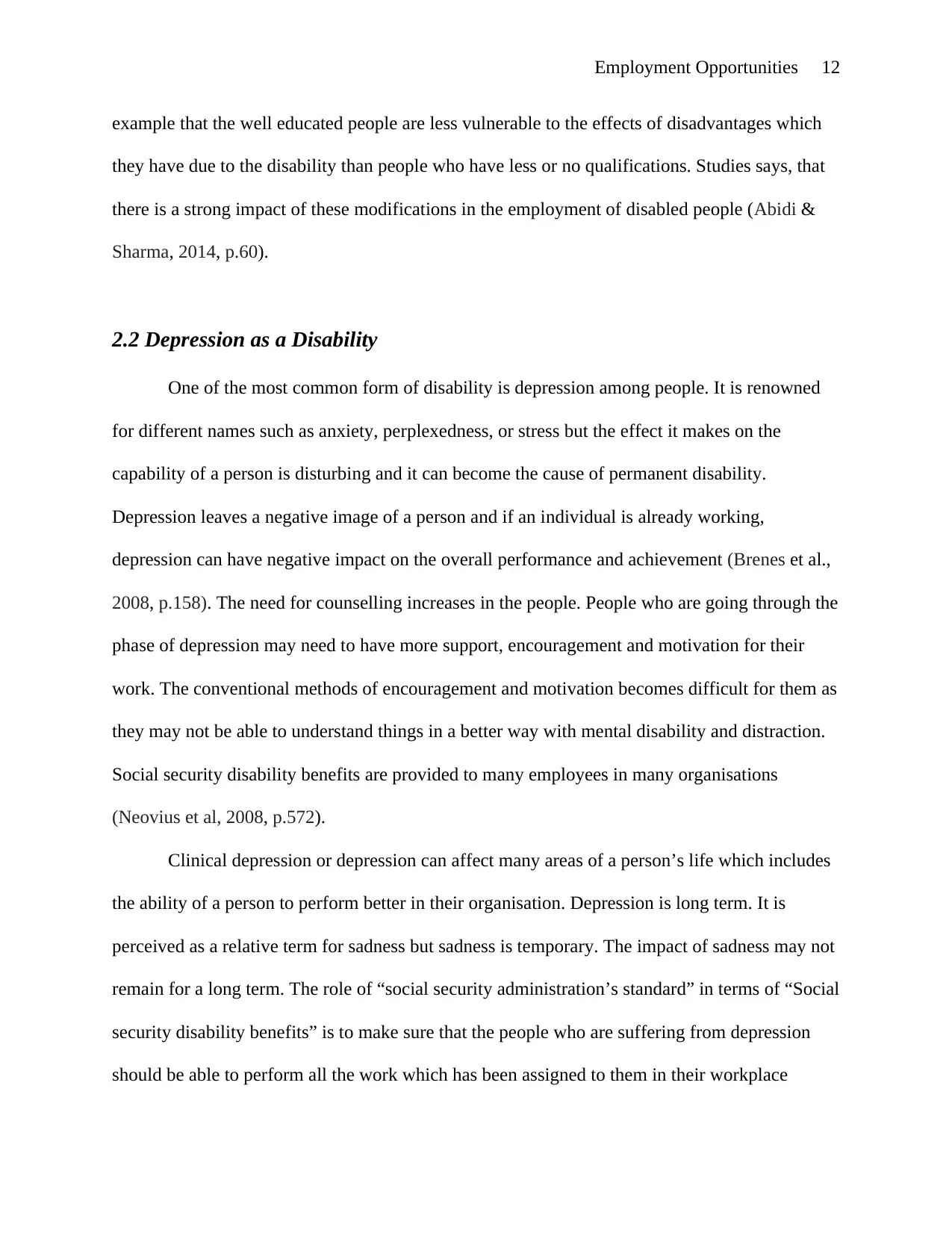
Employment Opportunities 12
example that the well educated people are less vulnerable to the effects of disadvantages which
they have due to the disability than people who have less or no qualifications. Studies says, that
there is a strong impact of these modifications in the employment of disabled people (Abidi &
Sharma, 2014, p.60).
2.2 Depression as a Disability
One of the most common form of disability is depression among people. It is renowned
for different names such as anxiety, perplexedness, or stress but the effect it makes on the
capability of a person is disturbing and it can become the cause of permanent disability.
Depression leaves a negative image of a person and if an individual is already working,
depression can have negative impact on the overall performance and achievement (Brenes et al.,
2008, p.158). The need for counselling increases in the people. People who are going through the
phase of depression may need to have more support, encouragement and motivation for their
work. The conventional methods of encouragement and motivation becomes difficult for them as
they may not be able to understand things in a better way with mental disability and distraction.
Social security disability benefits are provided to many employees in many organisations
(Neovius et al, 2008, p.572).
Clinical depression or depression can affect many areas of a person’s life which includes
the ability of a person to perform better in their organisation. Depression is long term. It is
perceived as a relative term for sadness but sadness is temporary. The impact of sadness may not
remain for a long term. The role of “social security administration’s standard” in terms of “Social
security disability benefits” is to make sure that the people who are suffering from depression
should be able to perform all the work which has been assigned to them in their workplace
example that the well educated people are less vulnerable to the effects of disadvantages which
they have due to the disability than people who have less or no qualifications. Studies says, that
there is a strong impact of these modifications in the employment of disabled people (Abidi &
Sharma, 2014, p.60).
2.2 Depression as a Disability
One of the most common form of disability is depression among people. It is renowned
for different names such as anxiety, perplexedness, or stress but the effect it makes on the
capability of a person is disturbing and it can become the cause of permanent disability.
Depression leaves a negative image of a person and if an individual is already working,
depression can have negative impact on the overall performance and achievement (Brenes et al.,
2008, p.158). The need for counselling increases in the people. People who are going through the
phase of depression may need to have more support, encouragement and motivation for their
work. The conventional methods of encouragement and motivation becomes difficult for them as
they may not be able to understand things in a better way with mental disability and distraction.
Social security disability benefits are provided to many employees in many organisations
(Neovius et al, 2008, p.572).
Clinical depression or depression can affect many areas of a person’s life which includes
the ability of a person to perform better in their organisation. Depression is long term. It is
perceived as a relative term for sadness but sadness is temporary. The impact of sadness may not
remain for a long term. The role of “social security administration’s standard” in terms of “Social
security disability benefits” is to make sure that the people who are suffering from depression
should be able to perform all the work which has been assigned to them in their workplace
⊘ This is a preview!⊘
Do you want full access?
Subscribe today to unlock all pages.

Trusted by 1+ million students worldwide
1 out of 44
Related Documents
Your All-in-One AI-Powered Toolkit for Academic Success.
+13062052269
info@desklib.com
Available 24*7 on WhatsApp / Email
![[object Object]](/_next/static/media/star-bottom.7253800d.svg)
Unlock your academic potential
Copyright © 2020–2026 A2Z Services. All Rights Reserved. Developed and managed by ZUCOL.





